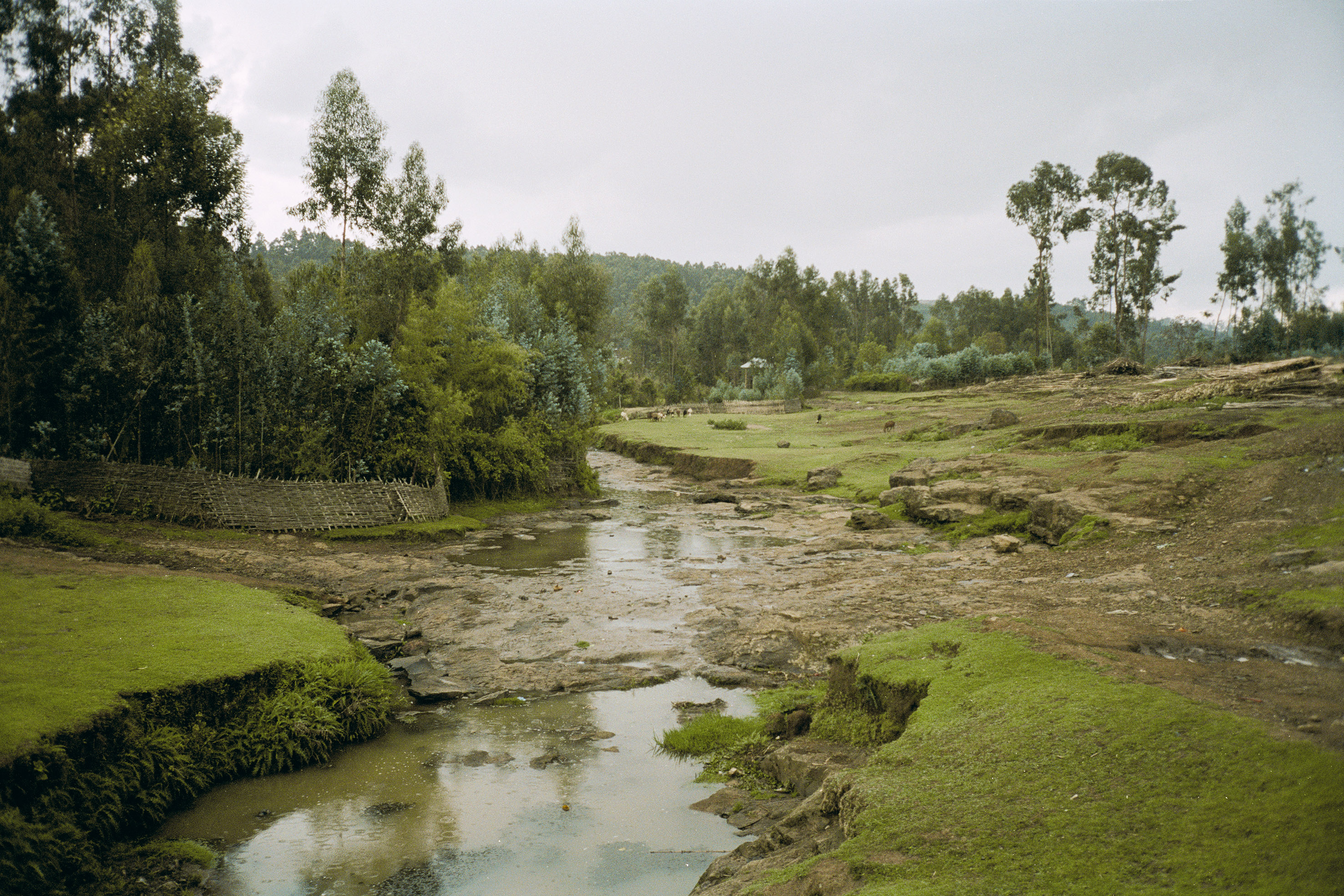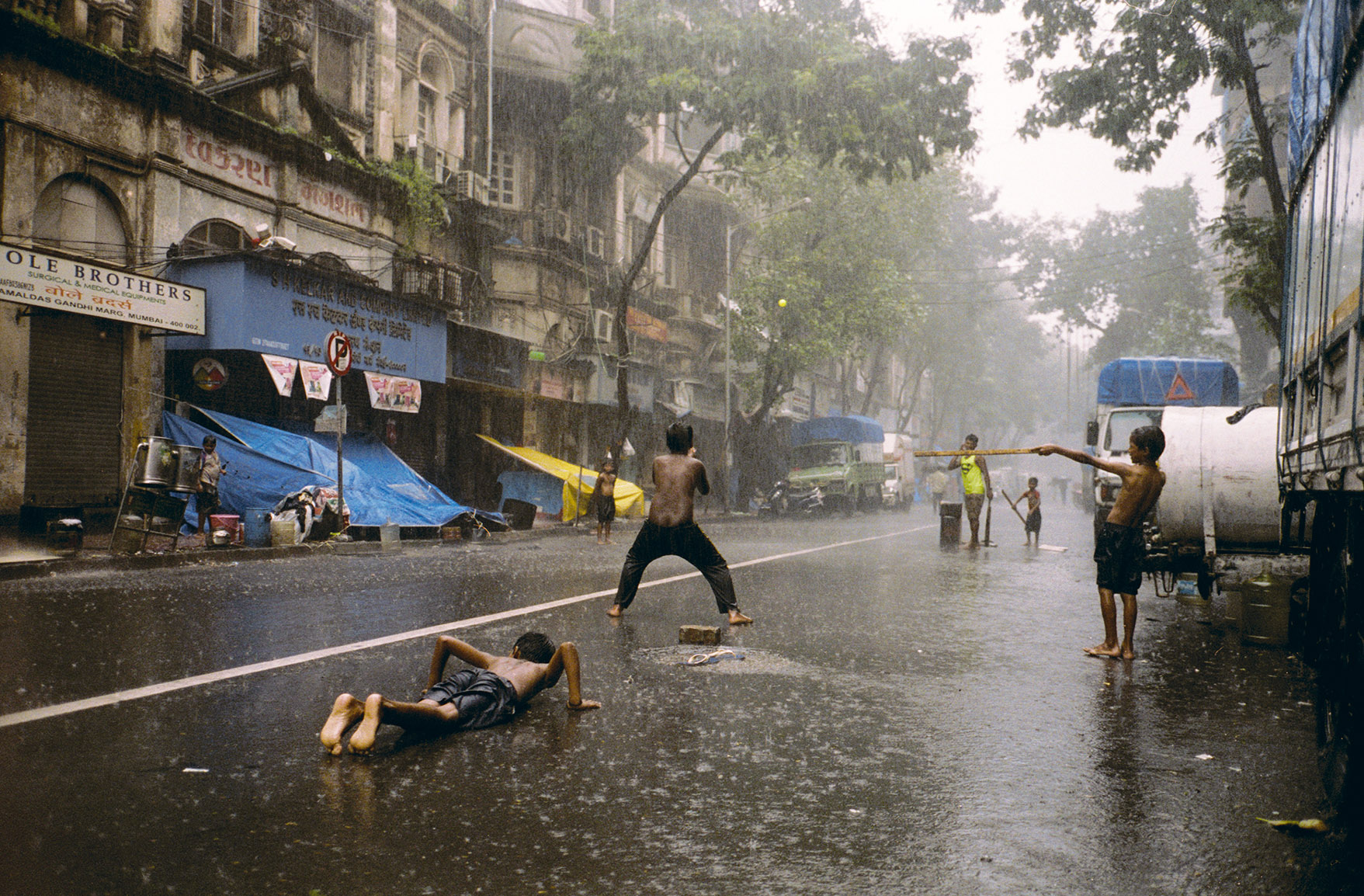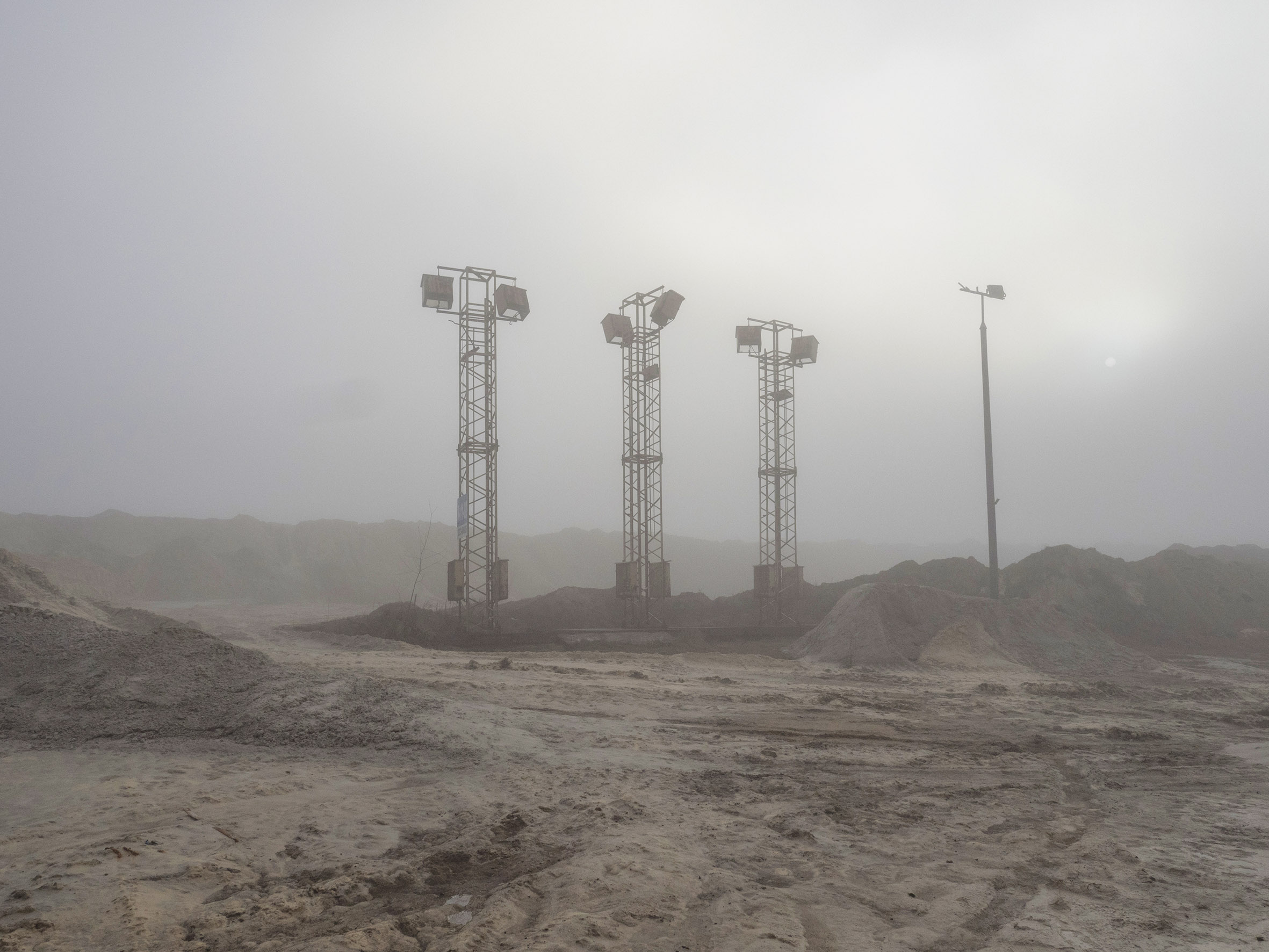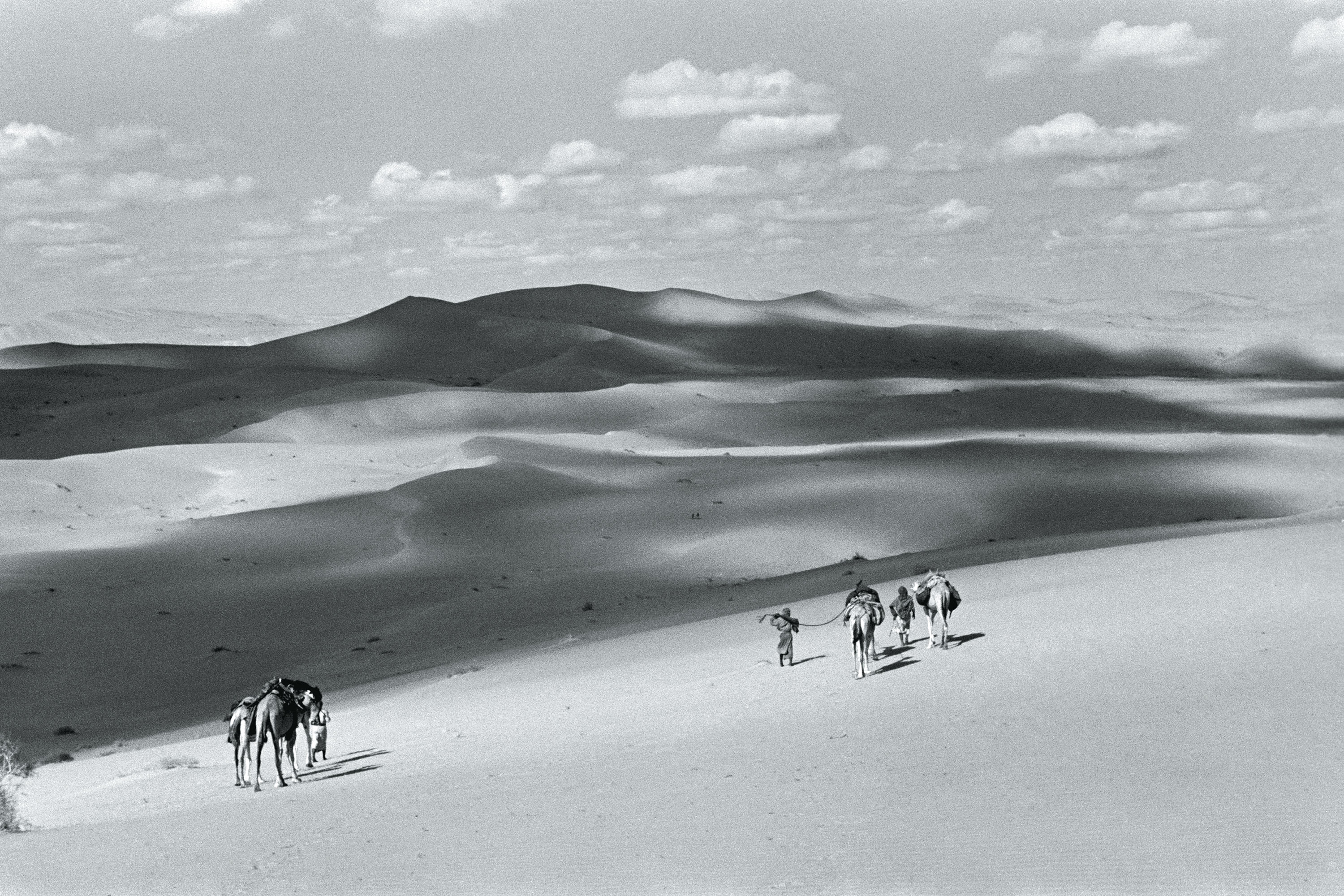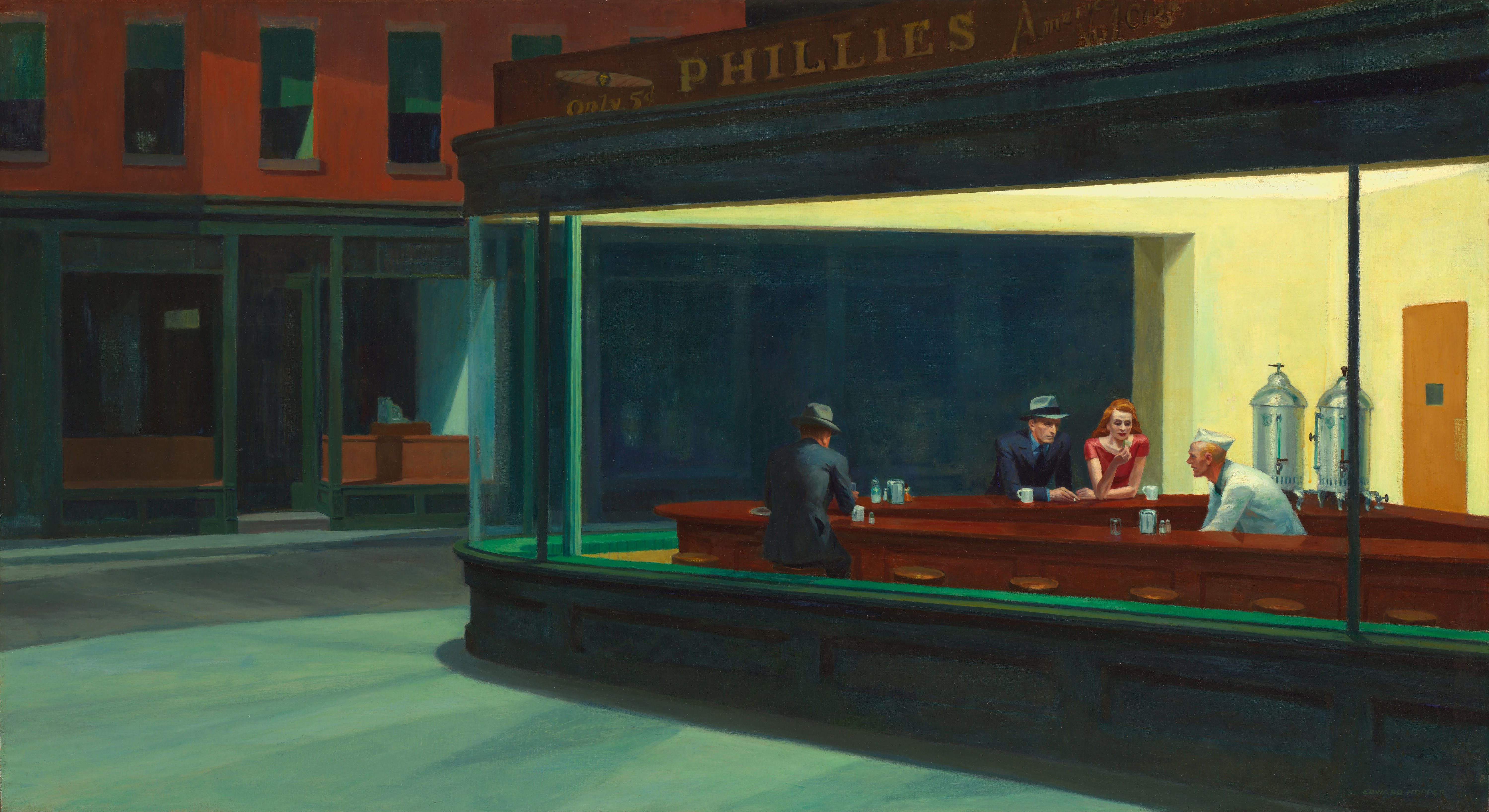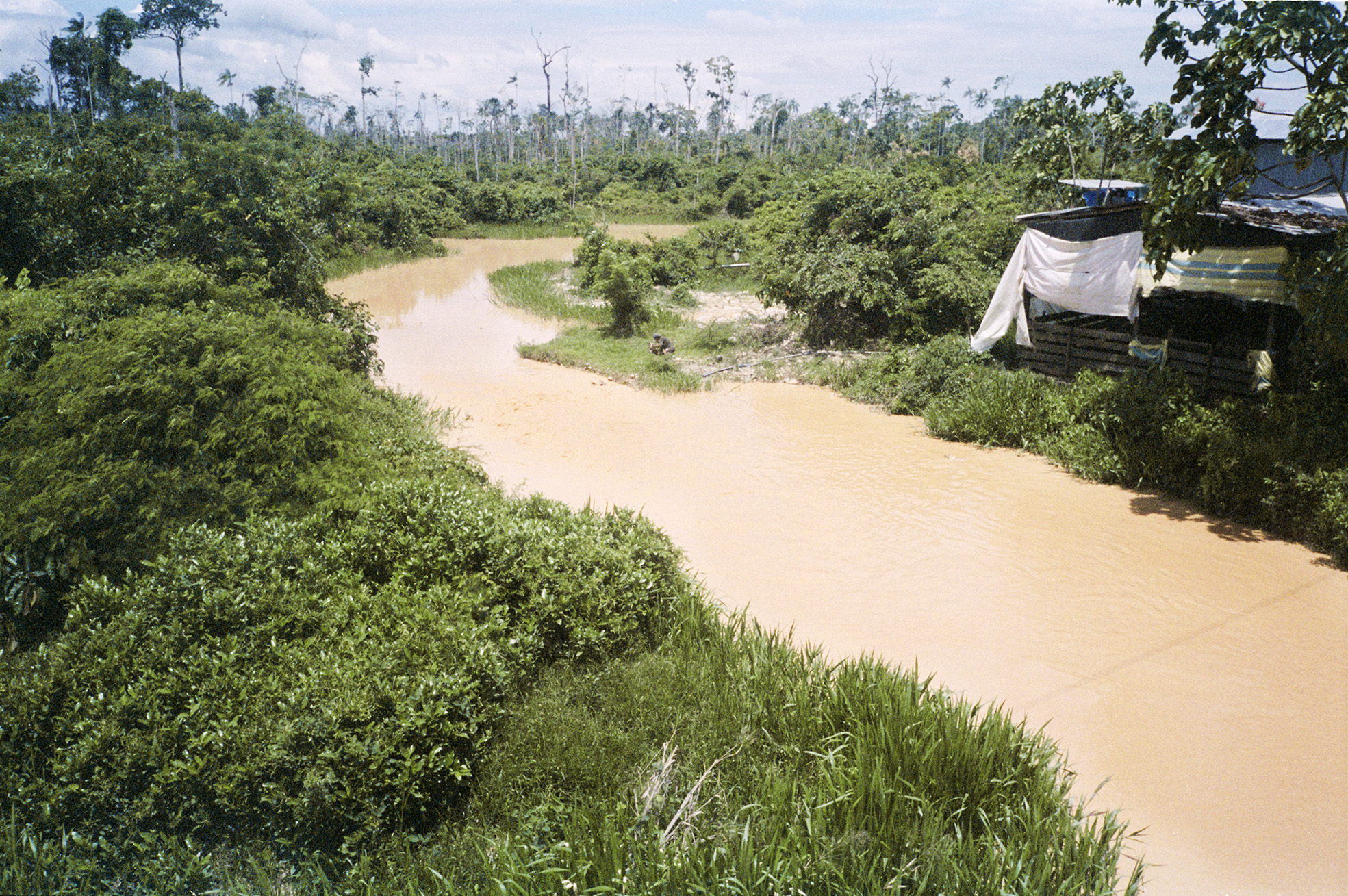
The Nile is elusive, like a strange enigma. Not only does it begin in several places, but it also hides and sneaks through rocky gorges. I look for it in the dried-up riverbeds and in trickling streams. In Africa, water remains a seasonal revelation, a pure miracle.
“This coffee needs a cigarette,” smiles Elijah, setting down a cup, having just slurped the last dredges of thick, sweet arabica. It was poured moments ago by a young coffeemaker. She took her clay pot off the hot coals and came to us, swaying her hips, clad in a floral dress. It might be just a crummy street café for tired drivers to rest at when they pass it by. Maybe they do serve dust and exhaust fumes with their breakfast specials. Her dress might have a hole in it. But when she pours the piping-hot liquid into the cups, she is an African queen.
We’re about to embark on the hardest part of our journey. For the first hour and a half, we will be driving down the coiled road, trying to avoid wooden carts, packed buses and pieces of chipped rock, wearing brakes thin on dozens of twists and turns. When we reach the bottom of what Ethiopians call Abay (a rocky gorge between the cities Gohatsion and Dejen, both located at 2600m above sea level), we will be stopped by the army to check if we aren’t carrying any weapons or explosives we could use to blow up the most important bridge in the country. It is 300-metres long and can support vehicles with up to 12-tonne loads. Built by Japanese constructors, the bridge connects the north and south of Ethiopia. Its destruction would slash the country in half.
Driving across the bridge is just a minute-long thrill. We are not allowed to stop, and there is just enough time to take clandestine photos of the concrete pylons, steel ropes and dark-brown water beneath the structure. Abay River is the smaller sister of the Blue Nile. It gives the Nile all its waters.
The closer we approach to the bottom of the canyon, the hotter it gets. We are dizzy and sweating. The coffee didn’t help, and our early departure isn’t working to our advantage, either. Noon is still hours away, and the heat is already insufferable.
“Let’s keep going,” I say.
Let’s get out of here, I think.
The way up is slower, it’s taking longer. The car is dragging its weight, engine howling. Water is dripping from the oil cooler, hissing under the bonnet. We drive past two broken trucks, packed with bags of freshly-picked cotton. When we pass the third, two of its tyres bust just as we reach it. The booming noise echoes among red rocks.
The camp of last hope
The Holy One is not pleased to see me. His eyes remain cold when he smiles, baring his small, sharp teeth. The air is stifling. The man turns his slim hand with its back upwards, making an inviting, yet still commanding gesture.
“Sit down,” he says, patting the air above the bench made of large pieces of eucalyptus trunks. I wait, while he talks in Amharic to a bald man with a hooked nose. Every now and again, they glance toward me and resume talking in hushed tones.
Adunya, the teenage shepherd who led me here, was told to wait outside. He has to stand behind the door made of corrugated sheet, where a meek crowd has gathered. Everyone who comes to the mountain must register first and receive a blessing. People are flocking, sitting and lying under a makeshift tarp marquee someone has stretched between trees. I was pushed right through, no effort required. White skin was enough to make way, flanked with surprise and wariness.
We came here with talkative Adunya across hills and rocky slopes, along riverbeds that have been long dry this time of year, and ploughed-up fields, waiting for the first rains to come. We left at dawn, and now the sun is high in the sky, burning hot.
I’m sitting in this dark hut with no windows, waiting for the men to finish. Finally, the bald one switches to English and asks me about the purpose of my visit with a smarmy smile. The Holy One sits sprawled on a plastic chair behind a table, strewn with various attributes of power: a mobile phone, notebook and pen. He is listening to my answer being interpreted to Amharic. He nods and asks a few more things about me: my first name, last name, religion, professional occupation, my ancestors’ faith, my nationality, age… The man writes it all down in his notebook, divided into orderly tables. His writing is as small as his hands and teeth. He is wearing an oval khaki hat and some kind of cassock in the same colour, albeit more dusty. On his chest glints a heavy metal cross, its arms spreading wider at the end, in a fashion typical for the Orthodox. The Ethiopian Church is one of the oldest and the largest in the world, with about 50 million worshippers in its flock.
I push the sheet metal door and stand in the sun again. I breathe. The bald one wraps his shoulders with a shawl and leads me to the main gate. He will be my guide to the last-hope camp. Several thousand people are living on the St. Mary Mountain (as it’s called by the locals, although there are dozens of such mountains, monasteries and churches in Ethiopia). The people live in small tents or tightly-packed huts, made out of foil and scrap wood, lining the pathways that cut across the slopes. These footways go over the whole mountain. They are so neat they give an impression of a city-like order, joined at the crossings, connected by vertical stone steps.
It’s astonishingly clean here, especially considering the crowds of people, the poverty and the heat. No litter lying about and rotting, even though there are people everywhere, lying along the pathways and on the squares, built in front of the churches. There are five such churches: round buildings of many doors. The largest and the oldest is 70 years old. This is where the Holy Father speaks. I didn’t manage to find out what his name is. He lives on top of the mountain and, according to my hawk-nosed guide, he is sustained only by prayer, abstaining from any foods and liquids. He speaks to crowds of worshippers regularly; this morning he was performing exorcisms. In the Ethiopian Church, this practice is nowhere near as rare nor exceptional as it is in the Roman Catholic one. They are a form of group cleansing ritual. One in three Orthodox Christians in Ethiopia believes that they have been possessed by evil spirits, or they know someone who has experienced it at some point.
Right now, the main square is relatively quiet. Despite the crowds, all human bodies are immobilized by a lethargic stupor; most are half-asleep or exhausted with illness. In huts and tents, the usual bustle keeps going: people are cooking, doing laundry, cleaning. There is more movement by the gates leading to the miracle springs. Hundreds of people are queuing. They stand in scorching sun, patient and humble. They are waiting for salvation. They have nothing left but hope.
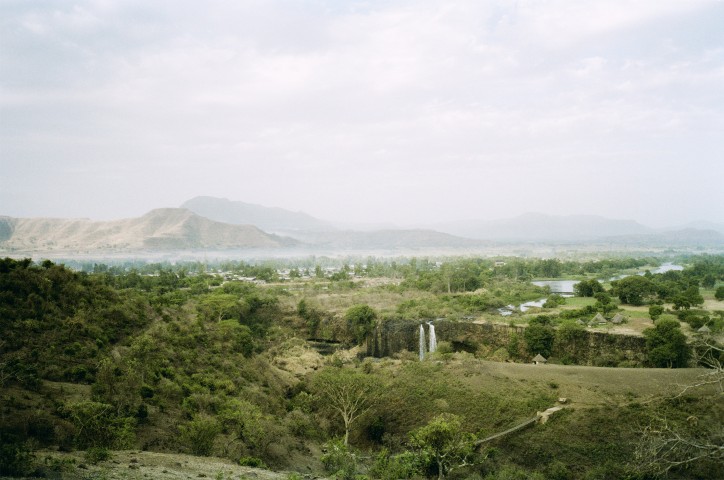
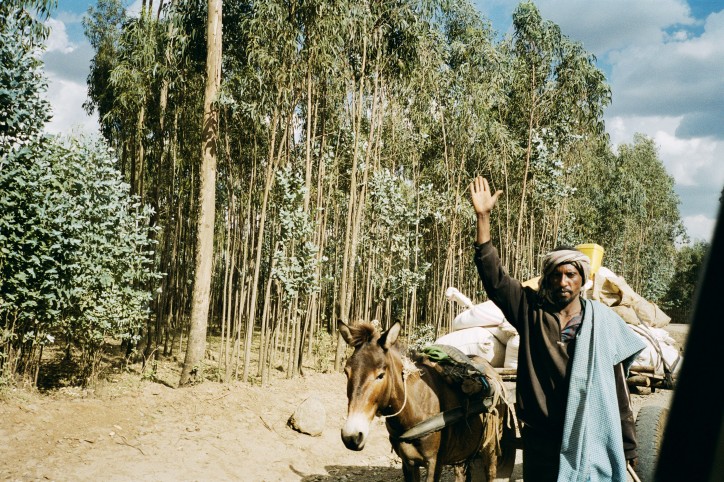
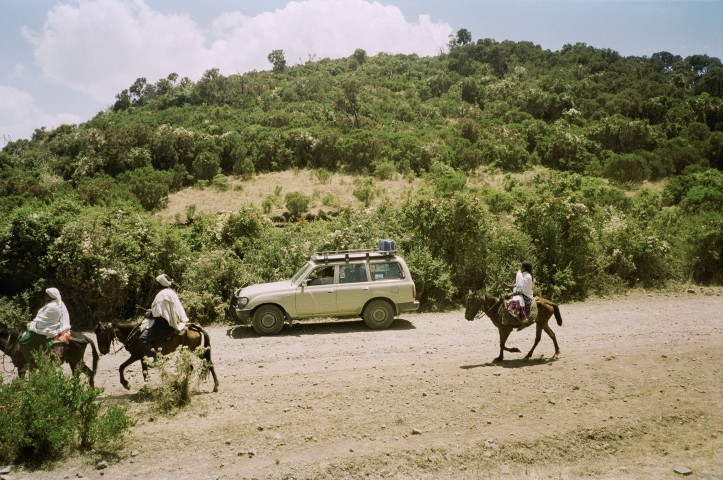
Just drink the water
My guide proudly informs me that there is not a single doctor in the monastery.
“All healings are thanks to the holy springs, and nothing else. There are four of them: holy water, oils, soil and the Holy Father.”
According to his stories and legends – which are repeated across the country and attract more pilgrims – water from the local spring can heal the most severe illnesses, especially tumours and AIDS. Has he ever seen any healings himself?
“Oh, plenty! I see them all the time. People get up and start walking without crutches, they just drink the water and are completely healed! Overnight. Aren’t they?” he asks, looking around the faces of people surrounding us in a tight circle. But nobody is nodding, no one makes the aou! sound, pronounced on the inhale and meaning confirmation. So the man continues: “I was healed myself! I used to suffer from schizophrenia and depression.” He claims to have arrived at the mountain eight months ago, and even though he has a PhD in Politics (from some Indian university in a city I have never heard of before), he confidently lists various illnesses that can be healed after drinking water from the local spring – just make sure you drink on empty stomach. There is only one condition: you must have faith.
We stand high on the mountainside from where most of the monastery can be seen. It looks like a giant refuge for runaways from the disappointing reality; a palace of supplication, made of thick sheets of blue plastic foil. Temporality patched up with junk and despair. Most of the people who come here have already tried treatments in various clinics and hospitals, but many of the residents don’t believe in medicine at all. What they do have faith in are evil spirits and divine interventions. The Magic Mountain is magnetizing, emanating hope. It keeps some people for a few days, while others stay for years. They lie on the ground, with their whooping cough and twisted limbs. They sit, exhausted, greyish, gaunt. They drink the water.
I ask about the money. Who is financing the whole thing, who feeds those people? The doctor of Political Sciences reassures me that everyone here lives in peace, the people here coexist in a happy commune, and no one ever goes hungry.
“The people share whatever they have,” he adds with a broad smile. He doesn’t want any money from me. When my visit is over, he shows me a donation box, but without pressuring me to do so. The guards, who searched my clothes and backpack meticulously before letting me in, now return my Swiss army knife. I leave the crowded nest of suffering behind and walk down, joining a constant stream of people. Am I walking among the healed?
Death on the Nile
They carry waterskins and plastic canisters, bottles and jugs, balanced on their heads and backs. They walk fast as if suddenly called by an urgent need, some usual, trivial business. Or maybe the opposite: as if summoned by someone’s pain and suffering they want to heal with the water they bring. They all go barefoot, some wear plastic flats or cracked sandals. Their clothes are dirty and torn, their T-shirts and ripped jeans look the same as everywhere in the world. Older women wear cotton gowns with embroidered edges, their heads and shoulders covered with shawls. Whole families walk together, little children running tirelessly in circles around the groups. The eldest and the weakest ride the mules that can be borrowed from the monastery. They will carry the people to the nearest town, walking near the hydroelectric power plant and across the old Portuguese bridge over the Blue Nile.
It is the reason why I came here; to see the longest river in the world (although some of the most recent studies claim the Amazon to be longer). Several kilometres beneath the monastery, the river flows down the fields, through the volcanic rocks, tumbling 45 metres down – a broad wall of water. The waterfall, one of the most magnificent in Africa, reaches a deep gorge, and just like the Rio Grande in the Grand Canyon, travels hundreds of kilometres, hidden beneath the rocks, until it reaches Sudan, where it joins the White Nile near Khartoum.
I go lower and lower, along the riverbed. A steady stream of pilgrims keeps moving the opposite direction, toward the holy spring. We wave and smile to each other. On their heads, they carry bags full of grain, bottles of oil, packs of toilet paper. So at least some part of the self-sufficient commune tale seems to have been true.
I stand on the edge of the precipice and look down. Vertical stone walls protect the greenish Nile water. Now there isn’t much of it left in the gorge, just enough to play in. Naked boys jump off the stone shelves, screaming with delight. How did they get there? I watch two kids who, having already shed their clothes, climb down toward the water, holding onto the rocky ledges with deft hands and bare feet.
Here, on top of the rock, dry heat is carried by the wind, forcing its way into my eyes, ears and throat. I spit out a gob of greyish foam. There is nothing left to drink. Upon reaching a stone bridge, I part ways with the crowd of worshippers. The construction is beautiful, built a few hundred years ago by the Portuguese. A decade ago, it was renovated by a group of international activists. Most of the pilgrims cross the bridge to reach a village called Tissisat, and I, together with my shepherd guide – who is now very hungry, and therefore less chatty – climb the mountainside leading to the waterfall.
On the shepherd path, we meet two young men leaning on their canes. They are arguing about something. Down the footpath, there is a small coppice where a sad teenage girl is sitting next to a toddler, lying in the shade on the grass. The child’s eyes are closed. Adunya translates bits of the arguments to me, explaining someone threw stones at the little girl, hitting her in the stomach until she fainted. She is probably bleeding internally right now. Her big sister doesn’t know what to do. The men are arguing about whether the child is still alive or not. If yes, they will carry her to the village. If not, they should leave the body here, so it doesn’t bring them bad luck. They chase Adunya away, looking at me like I’m trouble. They throw their arms in front of them.
“Go!”
Here, on the sprawling Ethiopian highlands, science, knowledge and rational thinking are just like water – almost inaccessible, requiring a lot of skill to find, and seldom used for development or a better life. Most people here know nothing but daily hardship. Whatever they have to endure has been there since before they can remember. I look at the waterfall. Even now, before the first rain, with only one-tenth of its usual volume, it’s still impressive. Its traditional name – Tis Abay – means ‘great smoke’, befittingly, because during the wet season water hitting the rocks produces clouds of white mist, spreading across the bay and the gorge. Now children’s laughter carries easily through its low hum. On a clearing nearby, girls are playing hopscotch, jumping and kicking a small pebble. Have they noticed one of them is missing?
We finally reach the village where I will stay for the night. I flop on the grass in front of a hut and pour a bottle of water down my throat. I can hear gunshots somewhere nearby. The sound kept me awake last night, together with rats scrambling on the hut floor. My driver complained that the rodents ate half of his rubber flip-flop. Later, when driving through the village, we will go past a funeral procession of a farmer, killed for not paying his debts. One of his friends will come to the funeral with a cocked gun, lamenting so vigorously that he will end up shooting himself to death. It won’t be the end of it, though. Vengeance will be in order, and soon one of the killed farmer’s rivals will die, too.
More than once on my way to the monastery, I was stopped by men with AK rifles. They carried weapons across their shoulders, holding them by both ends like a shepherd’s staff. They wanted to know where I was going and what for. We walked past several burned car cadavers, abandoned on the roadsides.
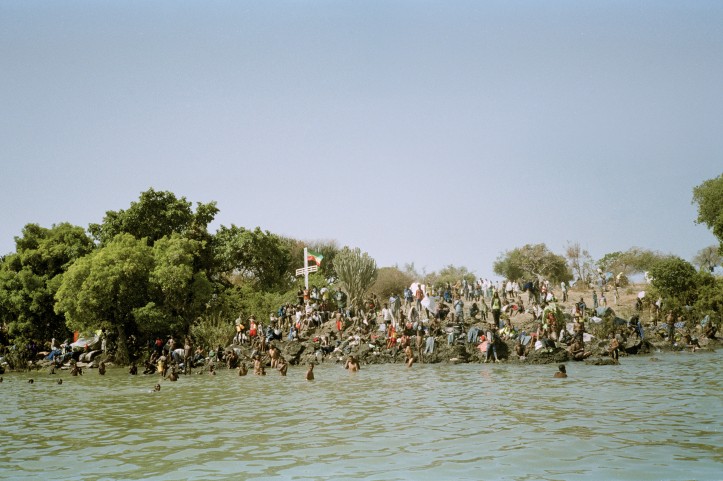
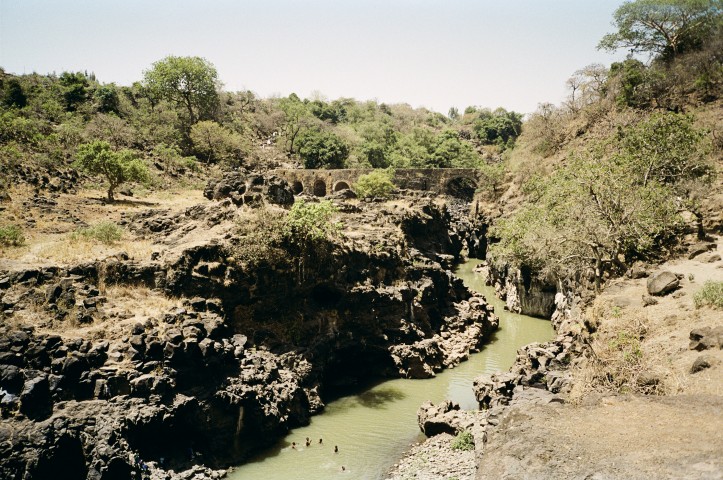
A time of change
For the past few years, Ethiopia hasn’t been the safe, peaceful place that it used to be for many decades. All members of the local elites that I speak to – restaurateurs, diplomats, hoteliers – tell me the same thing. It’s a moment of transition, a political transformation. The current Ethiopian government and the president are boldly democratizing the country. They allowed many dissidents and members of the opposition to return to Ethiopia. And those people are inexperienced and power-hungry.
We cannot enter every village. Elijah, who is driving our heavy, 31-year-old Toyota Land Cruiser, asks around every time before we take a turn off the main road. Minibus drivers, stall owners and wood-cutters tell him if it’s safe to go there. “Are you Bob Marley?” they joke. Sometimes they say: “Hey, Rasta!” Elijah is the same age as the car. He bought it at an auction from British Embassy employees in Addis Ababa. Elijah comes from Shashamane, the largest Rastafari community in Ethiopia. His father was Jamaican and came to Africa when called upon by the emperor Haile Selassie. But it was his Ethiopian Christian mother who raised Elijah and his three brothers to become devout men. Every church, chapel and wayside cross on our 1600-kilometre journey warrants a bow over the steering wheel while making the sign of the cross three times. Elijah exhibits the same level of attentive devotion to rolling his marijuana joints three times a day. He brings weed from his family fields; he insists that His Highness allowed Rastafarians to grow it there. Our trip has a soundtrack made of 2000 reggae and dancehall pieces; a wonderful gift from Elijah’s DJ brother.
The secret source
It is obvious where the Nile ends – it flows into the Mediterranean Sea by Alexandria in Egypt. But where does it start? The search for its source started in ancient times, and it was only 20th-century explorers who were able to provide a decisive answer. The White Nile, while being the longer one, carries only 20% of all the waters of this monstrous river during the rainy season. It has several sources, but its origin has been established in Lake Victoria, near the industrial city of Jinja in Uganda. The place has been transformed into a tourist attraction. It’s enough to drive to the shore outside the town, full of trucks carrying cargo from Kampala to the Kenyan port in Mombasa. Tourists can go pontoon rafting, or rent a wooden boat with engines pushing them through the currents to the plaque someone stuck on a buoy. It says that here is the point where the Nile river starts. There is a bamboo hut perched on some rocks nearby, selling postcards with a stamp, confirming the location.
The search for the starting point of the Blue Nile (owing this name to the inky colour its waters absorb from the various minerals they wash out from the rocks and soil) is more complicated. The massive river has several beginnings; different sources for different people. To date, only a handful of daredevils have managed to traverse the Nile in Ethiopia from start to end. It was first done in 1968, by Colonel John Blashford-Snell, who led the river expedition requested by the Emperor Haile Selassie. It took until 2005 for Les Jickling from Canada and Mark Tanner from New Zealand to go down in history as the first people to paddle the entire length of the Blue Nile in kayaks.
One of the sources of the Blue Nile, as established by the explorers, is the Tis Abay waterfall, where the river, so inconspicuous before, now gains pace and takes off to its secret journey through almost inaccessible gorges. But before the Nile falls into the rocky riverbed, its waters come out of Lake Tana, stretching for nearly 3000 square kilometres between the port city of Bahir Dar in the south and the derelict town of Gorgora in the north. It took us almost four hours to drive along the lake’s eastern shore.
Over 60 rivers flow into Lake Tana. But according to the people who live on the local islands, not all of them are Nile tributaries. The most important one is the Lesser Abay River, whose waters flow down from the mountains in Gojjam province and, instead of mixing with the lake, crawl through one side and flow out through its southernmost end. Then, 30 kilometres further out, they tumble down the waterfall, joining the Blue Nile that arches toward Sudan and carries on, all the way to Egypt. This phenomenon is easiest to observe during the rainy season, when the dark waters of the Lesser Abay contrast with the pale lake surface.
All I can do now is watch the tides stirring the waters and believe the boy who takes me for a trip around the lake in his motorboat. I ask him to go on the Nile, just for a few kilometres, but he refuses. The bottom is rocky, and it could destroy his boat. And even if that wasn’t the problem, the waters are closely guarded and we would be shot at. The river is strategically important for 100 million Ethiopians. Not only because it provides clean water for their country – a powerful player in the farming industry – but because the Nile is also an increasingly valuable source of energy.
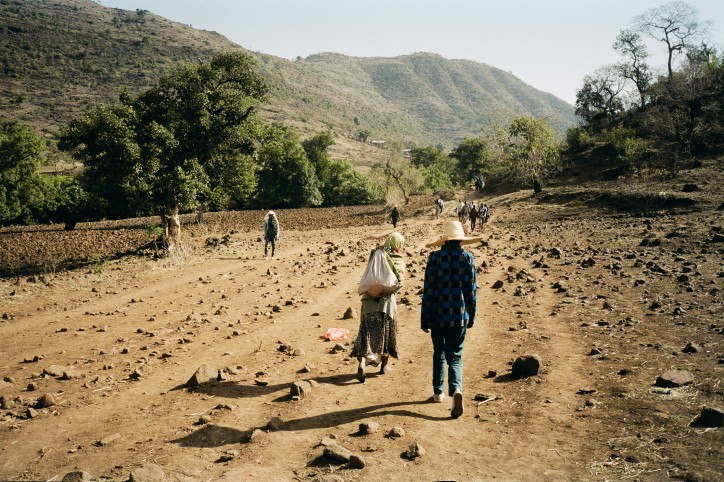
A time of renaissance
The lives of people in 11 African countries depend on the waters carried by the Nile. The years with less rainfall bring famine. More rain can at least provide some relief. However, nature no longer holds the nation hostage. Now, dams and hydroelectric power plants are the critical reservoirs of water and an invaluable source of the other vital resource: electric power. Ethiopia is waking up, and a new kind of hunger is gnawing at it – the country needs electricity. The economy is growing by 10% GDP per year, people are getting richer, tax-free agricultural products travel across borders and continents. For a long time, Ethiopia had been cut off from the rest of the world because of its war with Eritrea, and the unstable situation in Somalia and South Sudan. Now, the country is finally opening up its borders and starting to invest in the future.
The dream of a dam on the Nile was not a new one – Haile Selassie had already had this idea. It was funded by government bonds, bought for years by the rich as well as regular people. The construction of the Grand Ethiopian Renaissance Dam, located 40 kilometres from the border with Sudan, began in 2010. Its planned completion date is pushed forward time and time again, and even after the construction is finished, it’s going to take three more years to fill the reservoir with water. The investment, estimated to be worth $5 billion, was primarily funded by the Ethiopians, although some Italian and Chinese companies also participated in the construction process. The Chinese contribution is estimated to have amounted to a $1 billion loan to the Ethiopian government. The Grand Ethiopian Renaissance Dam will be the largest dam in Africa (with a storage capacity of 74 billion square metres), but the government has even more ambitious projects up its sleeve. During the next two decades, Ethiopia will invest $12 billion to produce 40,000 megawatts of hydropower a year. Some of it is going to be exported (to Sudan and other countries that are dependent on the Ethiopian energy supplies), but many Ethiopians believe that their fast-developing society will use up all of it alone.
Seeing the construction on the Nile will remain just a dream for me. Only 30 kilometres from Bahir Dar we are told that the road leading west is blocked. Behind the barriers, we can see a long line of cargo trucks and tank vehicles with humanitarian aid symbols on them. They are transports for refugees who come here mainly from South Sudan. Refugees flood border areas, staying in nearby villages and in several organized camps. The whole border area is dangerous, and the dam, located 200 kilometres away from the nearest city, remains inaccessible.
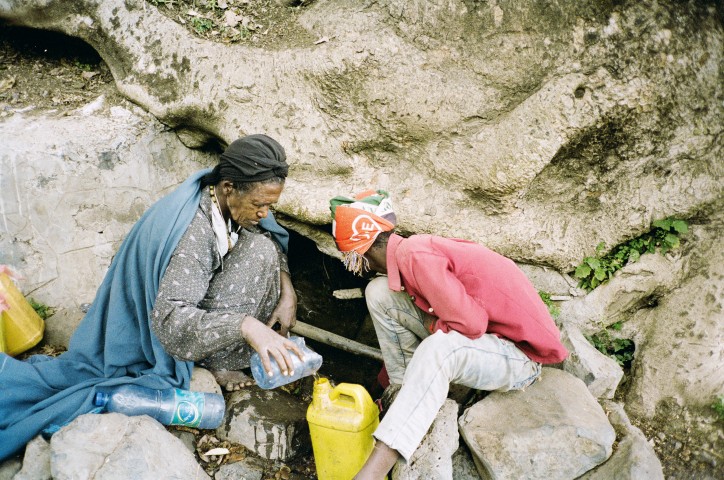
Everything flows
On Sunday morning, Lake Tana is bustling with life. Fishermen bring catfish and tilapia on their narrow boats, and the women working on the shore prepare the fish. They cut the heads off and make fillets. Clean fish meat is packed in one-kilogram bags and thrown into freezers. All this is happening 10 steps from the lakeshore, where hungry pelicans are waiting for scraps.
Other boats carry worshippers who, dressed all in white, are crossing the lake to attend the service in one of over 20 churches built on the lake islands. I choose the Debre Maryam monastery. We arrive at the shore, right next to a clump of tall reeds. When dried, it is used by the locals to make feather-light canoes. Most of the houses are built in the middle of the island, around the church, because it’s the highest area here. During the rainy season, water comes all the way to the houses, flooding the crops. The locals grow grains on small patches of land; some also own mango orchards. Their children sell the fruit to the monastery guests, or carry it across the lake to the market in town.
In the priest’s house, there is a family gathering. Old women are crouching under the walls. We join them. Someone’s brother-in-law is pouring cloudy alcohol, made of fermented grain. It’s strong – just one portion is enough to make the women’s eyes shine. The host’s wife is carrying a sleeping baby in a wrap on her back. She makes rounds among the guests with a platter of injera – a sourdough flatbread made with teff flour – and a pot of shiro, a thick broad bean stew, seasoned with paprika and curry. It’s a local staple, and often the only thing on the menu. Deft hands tear the bread, scoop the orange mush with it and put it into wide-open mouths. Young boys are roaming the hard earthen floor. After the service, the priest himself joins the party, wearing an impressive white turban. Upon his arrival, the conversation picks up.
People are laughing and joking. It would be easy to get the impression that this large family, spanning several lake islands and multiple generations, is living in equality and partnership. However, just one day of careful observation would be enough to realize that women have the heaviest load to carry – in a literal sense. Women are the ones who carry the water. Girls as young as four can be seen in the early morning, carrying three- or five-litre canisters in their hands. Teenagers and adult women have to haul 25 litres or more in one go. Old women carry the water, too – they tie clay jugs to their waists and walk slowly, bent in two. Young boys also bring the water, but adult men never do. Several kilometres one way, once or twice a day.
The people who live around Lake Tana are privileged. Most of the country have problems with accessing water, even in places near the Nile. Pumps and wells, guarded by stone walls or solid fences made of eucalyptus boards, are located in hard to reach areas. One must climb mountainsides and cross wild deserts first, then wait in a long queue, draw the water and carry it all the way back. Everyone is saving water – shoeshiners and housewives alike. You could drive across half of the country without seeing a single irrigation installation here; the crops depend on the rain. In mountain villages, the locals ask us to leave our plastic bottles. They will be handy for carrying water to work in the fields with them. When we were driving a mountain dirt track toward the northern part of the Simien Mountains, a boy stopped us. He had been walking since the morning and now was so thirsty he couldn’t even ask for a sip of water. He just gestured at his mouth with a pleading look in his eyes.
Water-carrying genius
Thirst is ubiquitous here. Parched soil is begging for rain, coughing up dust and sand. Pieces of volcanic rock fall out of the cracks. Riverbeds are strewn with bare, dry boulders. Now they look lost and forgotten, like props left useless after a theatre play. But when it starts to pour in June, they will bathe in fresh, icy water until October, and the river will make everything around it grow in all shades of lush green. Everywhere I go, everyone keeps telling me how wonderful this place will be when the rain comes. All the waterfalls, riverbeds and lakes will flow with life. Every hill and field will be covered with a thick carpet of green.
Sometimes, I’m tired of those idealized pictures. I’m fed up with those constant promises of mythical satiety and lush abundance that last only for one-third of the year. But I listen carefully. Those stories remind me that in this country, where most of the Nile’s waters take their beginning, every drop is priceless, long-awaited, miraculous.
Tiny mountain springs are believed to have magical healing powers. And the water itself is given divine, holy meaning. So much so that one could be dying of thirst right next to one of its streams, quite literally.
Before the Lesser Abay reaches Lake Tana, it draws its waters from a mountain river called Jemma. For this reason, some consider it the real source of the Nile. The Jemma River flows down a deep canyon near Debre Libanos, two hours’ drive north from Addis Ababa. It’s the first, spectacular massif leading to the magnificent Ethiopian highlands. Getting down to the river shore is impossible; four hours later, we only manage to reach the edge of a rocky precipice. Only professional climbers could get down there, and maybe a few local villagers, although even they prefer to get their water from the smaller tributaries. The canyon walls are carved with the deep scars of empty waterfall beds, but it’s easy to imagine what happens soon. Foamy water will rush down those giant creases, and their greyish-red rocks will grow a film of bright greenery. Will the voices of monks, singing nearby before dawn, carry as far and loud then?
Several churches have been built on the rocks over the Jemma. It is also home to the famed Debre Libanos monastery, founded in the 13th century by Saint Tekle Haymanot. The original building is now long gone, replaced by a modern church. Nearby, construction of a nursing home for the elderly is about to be finished. Ever since worshippers could reach this place by an asphalt road, the monastery has been under siege. Just like on the St. Mary Mountain, this church also has its magical spring, attracting those in need. Debre Libanos specializes in other ailments, though: it is favoured by the disabled, mainly those suffering from orthopaedic and mental health issues. Once they come here, they usually end up staying for years. Over the monastery, a village is sprawling. The huts here have been built with the same technique as everywhere in the country: first, a wooden skeleton is made of eucalyptus wood, then filled with mud mixed with straw. Roofs are laid haphazardly, using corrugated sheets that heat up hellishly, but it doesn’t leak and won’t have to be replaced every few months like the straw roofs. The huts have electricity and even satellite TV. One kilometre from here, the reason for all this trouble can be found: a thin stream of water, trickling from between the rocks. To find it, one must wade through heaps of plastic bags littering the streets and watch out for human faeces. At the miraculous spring, we meet a mother with her son. They collect the water with a cup made of a plastic bottle cut in half, and pour it carefully into their canisters. They are in no rush, even though two teenage girls with canisters are waiting for their turn just behind them. Around the spring, I can see several stale puddles, some squashed-up plastic litter. Silence. Not far from here, the road bends. Above it, there is one more church where holy baths can be taken in special concrete pools, only for the worshippers.
I go back to the main road and look at a boy, maybe 10 years old, who is sitting on a rock nearby, gazing at the magnificent gorge. He has a dirty canister with him, and hasn’t eaten since early morning. The boy is drinking miraculous water, hoping it heals his stomachache.
The oldest are the poorest. They live in cages that they built with scraps of wood; sheds no taller than one metre, with bamboo crates instead of doors. There are about a dozen of those, built near the bend in the road. This way, the beggars can see every passing car and ask for money or food. Old people sit or recline in their wooden boxes. Women chatter as if they were leaning out of the windows of their village homes. The men remain silent. They gaze ahead, wrapped in blankets and rags. They have nothing left to do but wait.
In the village, I see a woman with warm, friendly eyes standing in the doorway of her hut. She is sieving teff flour. The woman invites us inside, digs under a pile of rags and fishes out two stools. She pushes them toward us and sits on her bed – a precarious construction made of wood covered with rags and other kinds of filling. Behind a curtain hanging off a piece of twine, I glimpse the kitchen – a few scorched pots, squeezed under the table. There is no stove, just a fireplace with a few glowing embers of charcoal. The place is messy and neat at the same time. Everything is old and worn out, but placed in order, looked after with care. Every object here has its purpose. The hut is cosy. Our host generously lights her only lightbulb for us.
Now I see it: the hut is falling apart. The walls are torn with deep cracks, sagging, covered with sheets of plastic. They won’t survive the rainy season. The host, who looks about 80, has already collected the materials for repairs (eucalyptus wood and mortar), but she is still waiting for the workers to be sent by the monastery. They were supposed to arrive half a year ago. Officially, the hut belongs to the Church. The tenants have to pay rent and seek approval before any repairs or changes. The old lady sighs, grabs her cheeks. Her fingers sink deep in her loose skin.
She arrived here 40 years ago when she felt the calling of Saint Tekle. She bore four children – they all live scattered around the country. Sometimes they visit her and leave some money. A landless widow, she receives no pension or state benefits. Rent is her biggest expense: 300 Ethiopian Birr per month (£8); the electricity bill is 150 Birr. Water is another 150 Birr, sometimes more.
Even though the Jemma is flowing beneath us, and the holy spring is trickling nearby, the locals bring water from faraway wells. The old lady hires a 20-year-old boy to do it for her. He charges her 5 Birr a day for bringing a 25-litre canister to her doorstep. The lad used to be their local genius. He had a gift for maths, was doing great at school. But one day, someone threw a rock at him and hit the boy in the head. Since then, he’s been different. People say he went dumb. The only job he can do is carrying water.
The Church won’t help anyone who moves here. When I leave the old lady’s house, a young monk comes to her doorstep. Even those working for the monastery have to beg for food.
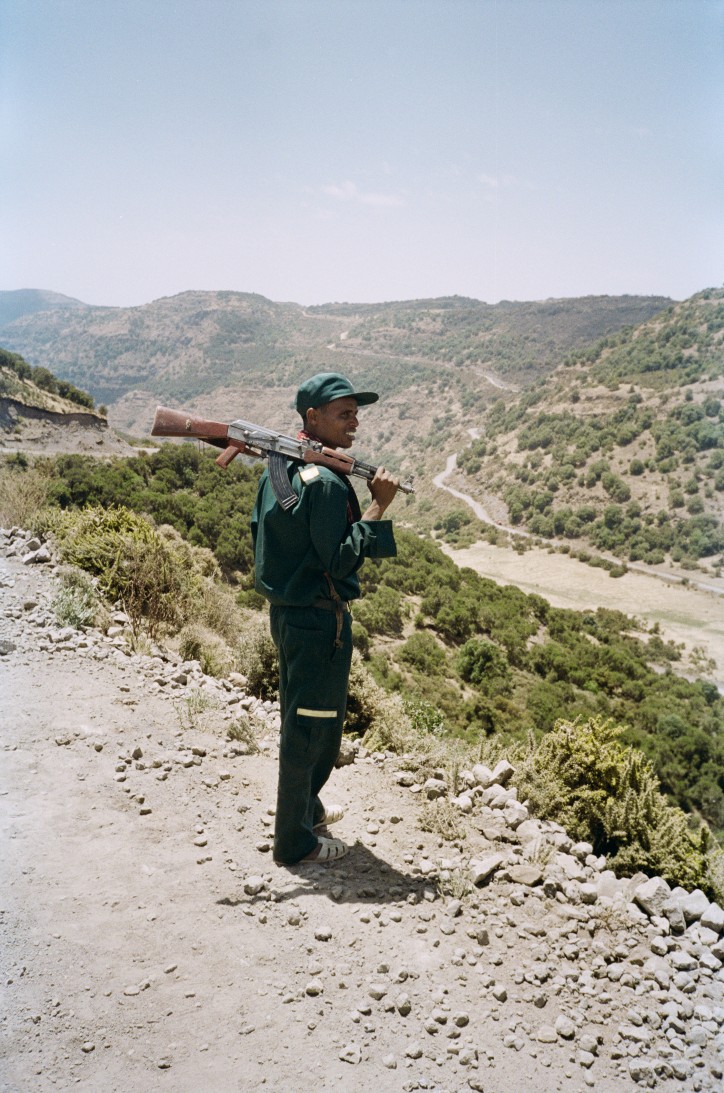
Forbidden miracle
We drive for most of the day. About 100 kilometres from Bahir Dar, we take a turn into a rocky village dirt road. The driver and the passengers leaving the minibus reassure us that it is safe here; we needn’t worry. Along the road, donkeys pull carts laden with bags of grain, piles of wood and straw. The late-afternoon sun is shining upon us, but we spot heavy clouds rolling ahead. When the rain falls, everything changes in an instant. Tyres skid on the slippery road, the ground slides between the rocks. Windscreen wipers are flailing helplessly, not making much difference anyway. We stick to the roadside, passing blurry silhouettes of people wrapped in dark-turquoise cotton shawls. In the curious mixture of sun and rain, they almost seem to glow. On the massive hill nearby, I can see the leftovers of a wood clearing. Two boys are carrying the last trees down. Now the whole hillside is bristling with fresh stumps. They don’t axe the trees down here. Instead, they poke at them with primitive iron tools that look a bit like giant crowbars with sharp endings, hammering around the trunk until the tree gives in. After the trunk falls down, the workers don’t cut it into planks, but pull it apart into uneven logs, using the same tools once again. The wood will be used to make huts, fences and sheds.
The mountain valley by the Gish Abay source has its own microclimate. It’s much colder here; green and rainy. We arrive at a town where a group of people have gathered on a small bridge, even though there isn’t much to see there. A white horse is nibbling on the grass over the trickling stream. Two Muslim women, who came here to fill their canisters with water. A group of goats are drinking water, the young goatherd watching them with a yawn. Having exchanged customary greetings, the locals direct us to the monastery, where another holy spring runs. This one is the most important of them all.
The miraculous properties of Gish Abay have been scientifically proven. For over 100 years, it has been known as the source of the Lesser Abay River, making it the actual starting point of the Blue Nile. There is a religious interpretation, too – according to local Orthodox Christians, it is the source of the river connecting the Earth with Paradise. Careful not to slip on the wet ground, we walk down, away from the church, surrounded by hundreds of worshippers. We follow the directions we received from some local man. We go past the herd of goats and are joined by three teenage boys who show us the way to the spring. Or rather, to the bamboo fence, built by the local priests, who decided to trap and confiscate it. The Ethiopian Church insists it has an exclusive claim to accessing and distributing the waters of this miraculous spring, insisting the Old Testament supports its right to do so. Since recently, only the priests are allowed to draw water from the spring. There is a hut next to the fence, surrounded by dozens of canisters. The containers also hang from a tree nearby, making it almost look like Christmas came early. In the village, selling bottles and canisters is the best possible business; there are dozens of stalls offering a variety of water containers. And seeing the crowds gathering in the church despite the late hour, I figure that business is going well.
Modest beginnings
I walk along the very beginnings of the Nile, near the shallow riverbed running next to the village, across the fields. The water is more stagnant than trickling, here and there squashed bottles and rubbish litter the stream. A modest beginning for the spectacular journey that awaits it further on. The Nile will travel across mountains and deserts, all the way to the Mediterranean. I can hear dogs barking in the village. A teenage shepherd is watching me. Rising voices stop me from enjoying the walk. Elijah is waving at me, asking me to come back. The elders have come from the village. They are annoyed, saying that we were not allowed to go down to the river, even though the pathway is open and it leads to the neighbouring village. The locals insist that only those who receive permission from the priests can come here. Three men with dark, gaunt faces demand that we go to the church and explain ourselves. The boys who led us here are scolded, and then each receives a smack with a stick on his back for good measure.
No explanations work. The people stand stiff as stone. We start walking uphill; they follow us. Just before the church, we turn abruptly and go to the car, surrounded by the local children. A snotty toddler with a naked bum laughs delightfully and helps me close the car door, waving goodbye. Elijah floors it, rusty mud sprays from underneath the wheels. We’re still tense, but we are happy, too. We have found the source of the Nile.
Several kilometres away, we stop among the fields. I share some Polish dry sausage with Elijah. As if to celebrate with us, a rainbow appears. No, not just a rainbow – there are three. Three full rainbows, their sharp, bright arches deep into the soil, sprayed with the first rain.
“This rainbow needs Bob Marley,” announces Elijah and plays “Could You Be Loved”.
![]()
Translated from the Polish by Aga Zano


